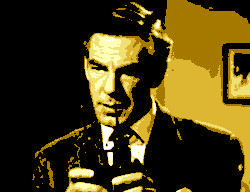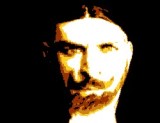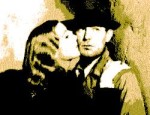Film Review
After the British company Hammer had effectively revived the classic
horror movie in the late 1950s with its series of Gothic horror films,
Anglo-Amalgamated gave the genre a further shot in the arm when it
released three films which later came to be dubbed the 'Sadean Trilogy'
on account of their sadistic portrayal of physical violence.
Horrors of the Black Museum was the
first out of the bag, followed by Sidney Hayers'
Circus of Horrors (1960) and
Michael Powell's
Peeping Tom (1960), each film
depicting a maniac who goes on a killing spree as a result of a twisted
personal obsession. At the time, all three of these films were
fiercely lambasted by the critics for their sensationalist depiction of
cruelly executed murders that were accompanied by large amounts of gore and more
than a smattering of tawdry eroticism. Whereas Powell's film
struggled to find an audience (after the critics had pretty well
destroyed the director's reputation and ended his career), the other
two were phenomenally successful and brought about the craze for
exploitation horror which took off with a vengeance in the early 1960s
and continues to this day.
By today's standards,
Horrors of the
Black Museum is ludicrously mild. Each brutal killing is
staged as a piece of Grand Guignol theatre that is more comical than
frightening, but audiences at the time were pleasurably shocked by what
they saw. The film begins with a seemingly innocuous scene which
ends with a woman having her eyes and brain pierced by spikes springing
from an ordinary looking pair of binoculars. Later on, a buxom
blonde is guillotined in her bed, and then an unsuspecting doctor is
reduced to a skeleton after being electrocuted and immersed in a
bubbling vat of acid. Mostly it is horror by suggestion, with
just a fleeting glimpse of something nasty, but the gruesome nature of
the killings gave the horror film a more sadistic and exploitative edge
than the genre had ever known before. It's interesting that the
next film in the sequence,
Circus of
Horrors, should be set in a circus big top, with each of the
murders played out before an enthusiastic crowd of onlookers. In
bygone centuries, crowds flocked to watch a public execution and now
cinema was performing the same role, providing a forum where human
beings could wallow in the suffering of others. The more horrific
the spectacle of murder and mutilation, the more authentic the
suffering experienced by the victim, the greater is our sense of
enjoyment. We are all voyeuristic little sadists at heart.
Horrors of the Black Museum
lacks the flamboyance of
Circus of
Horrors and terrifying reality of
Peeping Tom, and despite its
obvious horror trappings it feels more like a deranged black comedy
than an example of the genre it helped to spawn. Were it not for
Michael Gough's riveting central performance as a sensation-hungry
writer morbidly obsessed with murder the film would be pretty mundane,
just a pantomimic succession of implausible killings lined up to
titillate a cinema audience comprised mostly of easily pleased
Neanderthals. The script is dire and Arthur Crabtree directs the
film (his last) with an obvious lack of enthusiasm and artistry.
Crabtree, who had once scripted several Will Hay comedies and many of
Gainsborough's popular period melodramas, was drafted in to direct the
film after his previous directorial assignment for Anglo-Amalgamated -
the sci-fi shocker
Fiend Without a Face (1958) -
had made the company a small fortune.
Attractively photographed in CinemaScope and vibrant colour,
Horrors of the Black Museum gets
away with its cheap theatricality through some memorable visuals and a
shamelessly scene-stealing performance from Michael Gough, who
positively revels in his first leading film role. Gough would
become closely associated with British horror in the sixties and
seventies, through appearances in such films as
The Phantom of the Opera (1962),
Black Zoo (1963),
Horror Hospital (1973) and
Satan's Slave (1976), but he is
now more famous for playing Alfred Pennyworth in four of the
Batman films directed by Tim Burton
and Joel Schumacher from the late 1980s. Like Vincent Price, one
of the actors who was considered for the lead role of Bancroft, Gough
possesses a natural aura of malevolence that is completely belied by
his cultivated and gentlemanly persona. As soon as he appears in
shot, it is at once evident that he is the villain of the piece - and
this is one of biggest failings of
Horrors
of the Black Museum. Gough never gives us cause to doubt
that he is the man behind the killings - the only real surprise is how
far his own particular brand of homicidal lunacy will take him as he
makes a four course meal of every bit of scenery he can find.
Like Mark Lewis in
Peeping Tom
and Dr Rossiter in
Circus of Horrors,
Michael Gough's Edmond Bancroft is a charming and seemingly benign man
of immense social worth who is driven to murderous extremes by an
all-consuming obsession stemming from his sexual inadequacy. He
doesn't just kill for profit (creating news stories from which he will
benefit as an author of sensationalist reports); he does so in response
to a primal urge to assert his masculine authority over the women he
cannot control. He finds a willing substitute for the subservient
female in Rick, a susceptible young man whom he can readily hypnotise
into carrying out his crimes and other household duties (we can only
guess at what this might entail). What Bancroft cannot have he
destroys, with somewhat more in the way of maniacal fervour than his
counterparts in Powell and Hayers' films. Gough's chilling
portrayal of Civilised Man succumbing to his bestial insticts provided
a template for all those maniacs who would hack their way through the
unending slew of psycho-thrillers after the success of Hitchcock's
Psycho
(1960). Film horror was starting to live up to its name.
© James Travers 2015
The above content is owned by frenchfilms.org and must not be copied.



